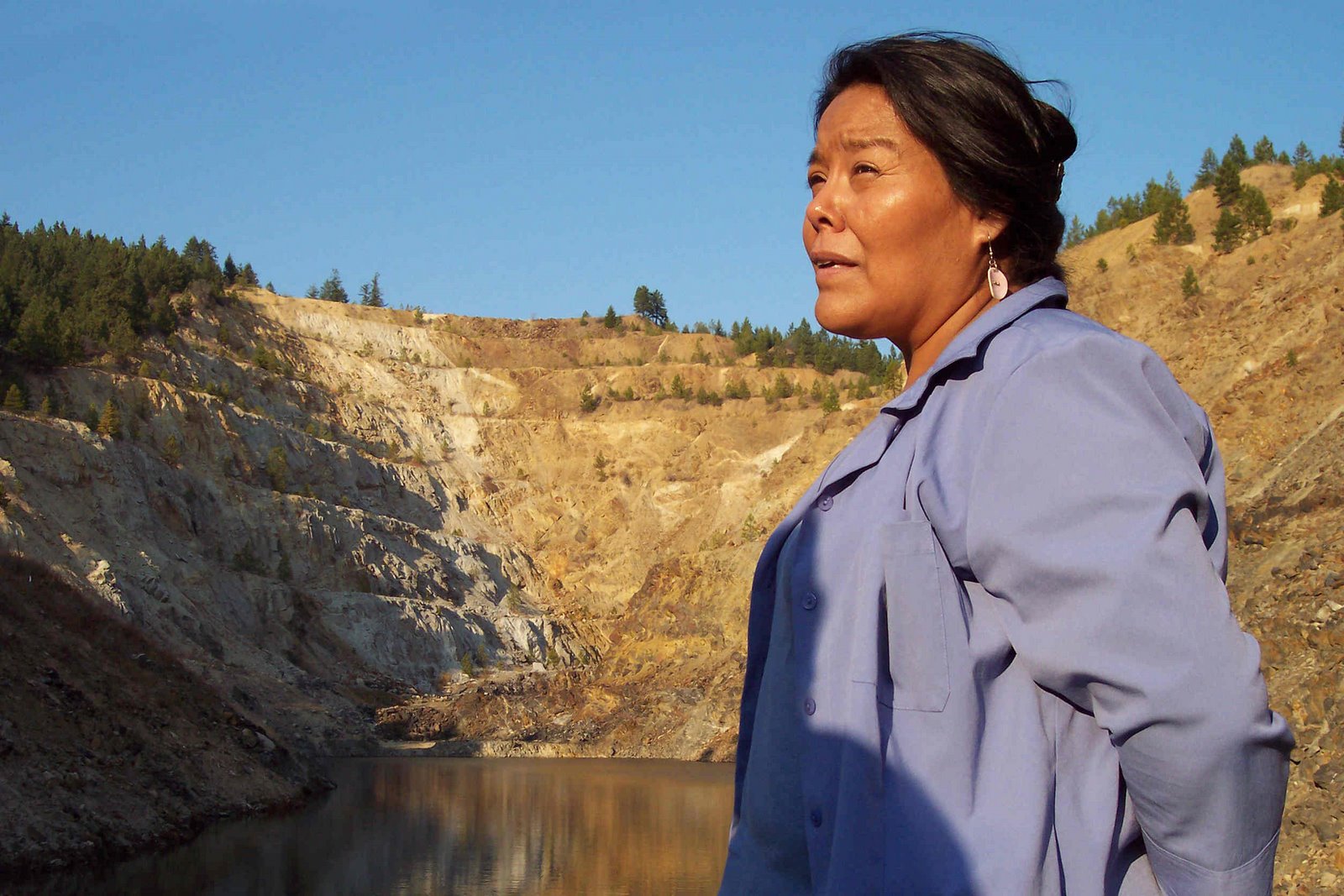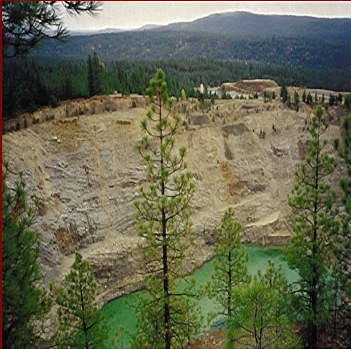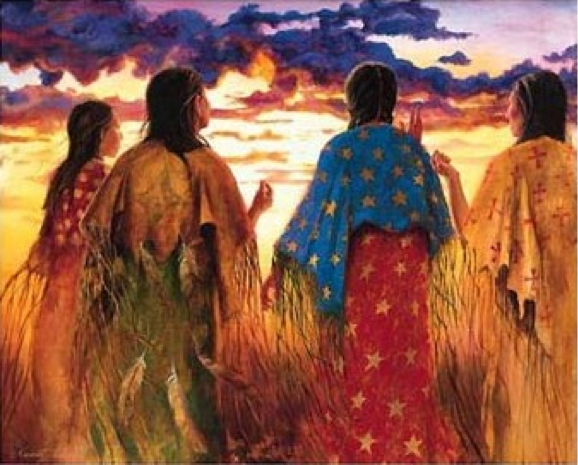June 6, 2011
Chico Corral blames uranium industry for failing health
But as others before him have learned, compensation is elusive
Charlotte Corral breaks down in tears while speaking about her husband, Chico, in their home on the Spokane Reservation. Sandra Belvail, a volunteer advocate who is helping Chico make a radiation compensation claim, offers comfort.
Chico Corral couldn’t get away from the dust. After the daily blasting, yellow-brown grit hung in the air at the Midnite Mine, an open-pit uranium mine on the Spokane Indian Reservation where Corral worked without a mask or respirator. Later, he breathed in dust during the years he worked at a uranium mill.
“We sucked all that into our lungs,” he said.
His family couldn’t escape the dust, either. It coated his work boots and coveralls. His daughter, Rachael Corral Henry, remembers running to meet her dad when he came home from work. “It was like he’d been in a sandstorm,” she recalled.
In his living room, in the blue recliner where he spends most of his days, Corral pauses to cough, spitting phlegm into an empty milk carton.
Now 79, Corral’s lungs show signs of scarring. Minor exertion leaves him short of breath. He believes his lung problems resulted from the two decades he spent in the uranium industry.
For the past three years, Corral has tried to get compensation through the Radiation Exposure Compensation Act, or RECA. The federal legislation allows former uranium workers to collect up to $100,000 for health problems that arose from their work.
From the 1940s through the 1960s, the United States conducted nearly 200 atmospheric nuclear weapons tests. Domestically mined and milled uranium was essential for the effort.
The act covers uranium miners, millers and ore truck drivers who worked in the industry through 1971. People who lived downwind of Nevada’s atomic test site are also covered.
In a 2009 letter, the U.S. Department of Labor acknowledged that Corral had been diagnosed with chronic obstructive pulmonary disease, but it said he didn’t provide evidence that linked the disease to his work history.
Efforts to document Corral’s work history and exposure levels have turned into endless rounds of paperwork for him and volunteer advocate Sandra Belvail. They’ve had to track down decades-old payroll records and medical reports.
Corral was never seen by a doctor specializing in industrial exposure, which makes his claim more difficult, said Belvail, a retired nurse practitioner.
As she’s worked on Corral’s claim, she’s been shuffled among 15 employees at the U.S. Department of Labor and U.S. Department of Justice, which administer the program. When they tried to reschedule a hearing this spring, Corral received a letter telling him to call a nonworking phone number.
Former co-workers who started the claims process gave up.
“If they drag this process out, these guys will be gone,” Belvail said.
Several hundred former uranium workers on the Spokane Reservation could be eligible for compensation. Nontribal members, as well as Spokane Indians, worked in the industry. Corral isn’t enrolled in the tribe, though his late wife was.
A federal grant could help former tribal uranium workers navigate the complicated process. The Spokane Tribe of Indians recently applied for a $900,000, three-year grant from the Department of Health and Human Services.
If the grant is awarded, the tribe would hire caseworkers to help former uranium workers assemble their RECA applications, said Deb Abrahamson, executive director of the SHAWL Society, a nonprofit activist group that was a co-applicant on the grant along with Indian Health Services.
Former uranium workers also would get screening for occupation-related illnesses.
The Navajo Nation has used a similar approach to help its members secure more than $450 million in compensation. Eight full-time employees at the Office of Navajo Uranium Workers help people with the paperwork, said Lawrence Martinez, program director.
As his own medical condition deteriorates, Corral worries about his family’s health. He fears that by carrying dust home on his clothes, he also exposed them to radiation and heavy metals.
His wife, Eveleen, died of leukemia. One of Corral’s daughters also has the disease. During a recent checkup, Corral’s 39-year-old son, Gabriel, was told that he had spots on his lungs.
“They know what’s true,” Corral says of the federal government.
‘That dust was everywhere’
Corral grew up near Los Angeles and spent part of his military years at Fairchild Air Force Base. After his discharge, he married Eveleen. They raised seven children on the Spokane Indian Reservation, where natural beauty is abundant but jobs are scarce. Corral was glad to hire on at the Midnite Mine. “He always said, ‘Thank the Lord that I can work another day,’ ” recalled Gabriel Corral, Corral’s youngest son.
Initially, Corral worked as a truck driver for contractors that transported ore. Later, he worked as a handyman at the Midnite Mine and as a “powder monkey,” the employee who filled drill holes with explosives.
He was also a prober. When the dust cleared after explosives detonated, Corral went out with a Geiger counter to measure ore grades.
As a young man, Corral occasionally smoked a cigar or a pipe. But he believes his lung disease was caused by dust from uranium ore. When Corral worked in the open pit mine, he had regular bouts of pneumonia.
When Dawn Mining Co. opened a uranium processing plant near Ford, Wash., Corral took a job there.
Financially, those were good years. In the early 1980s, Corral earned nearly $21,000 annually – the equivalent of about $52,000 today.
Eveleen Corral waged housekeeping battles against the dust that came with the paychecks. Her husband hung up his work clothes in the entryway. For fun, Gabriel Corral punched his dad’s coat to see the dust explode from it.
“All that I remember is yellow, yellow, yellow,” said Corral’s daughter, Rachael. “That dust was everywhere.”
Eveleen Corral was fastidious about changing the bedsheets, her daughter said. But piles of dust still accumulated on the floor under her husband’s side of the mattress.
Eveleen Corral died at 54. At the time, no one in her family questioned if her leukemia was related to uranium exposure.
Dawn Mining’s management had repeatedly told employees that working with uranium ore carried little risk, Chico Corral said.
The year her mother died, Rachael Corral Henry was diagnosed with lupus and rheumatoid arthritis, both autoimmune diseases. One of her sisters has leukemia.
“I believe it was part of what happened,” Rachael Corral Henry said.
Claim takes skills of Nancy Drew
Three years ago, the Department of Justice held a meeting for former uranium workers on the Spokane Reservation. Corral learned he could submit a 22-page RECA claim for compensation.
Corral’s first claim application was turned down, with the rejection letter acknowledging his lung disease but saying his claim didn’t substantiate his work history. That’s when Belvail got involved.
Belvail retired from the Department of Veterans Affairs Medical Center in Spokane, where Corral was one of her patients. She volunteers her time to help veterans with government claims. Corral’s is the most difficult she’s worked on.
“I’m glad that I read a lot of Nancy Drew detective stories when I was a kid,” Belvail said, “because that’s what this is all about.”
First, she had to prove that Corral was exposed to radiation and heavy metals. Copies of his Social Security records weren’t good enough. They outlined the years Corral worked for Dawn Mining, which operated both the Midnite Mine and the ore processing plant. But they didn’t have job descriptions.
To prove that Corral’s work duties exposed him to chemicals and radiation, Belvail pored over pay ledgers at Dawn Mining’s office in Ford. Based on what she uncovered, Bob Nelson, a Dawn manager at the closed mill, signed an affidavit, confirming Corral’s job history.
Because Corral received most of his health care through a local clinic, linking his health history to his work has been difficult. “They didn’t make definitive statements that his illness was related to occupation,” Belvail said.
Corral has diabetes and heart and kidney disease in addition to lung problems, which further complicates his claim.
RECA administrators rejected Corral’s claim for compensation for kidney disease, even though kidney disease can be linked to uranium. “They said it’s from my diabetes,” Corral said.
Diabetes frequently leads to kidney and heart problems, Belvail acknowledged. And Corral’s heart problems probably contribute to his shortness of breath, she said.
Belvail wants Corral to be seen by an occupational health specialist before he has a final hearing on his claim.
Charles Miller, a Justice Department spokesman, said privacy laws bar the agency from commenting on individual cases. But Miller said the program has paid out $16 million for 247 claims in Washington state since 1992, an average of $65,000 a claim. Two of the claims were from the Spokane Reservation, he said.
Corral believes time is running out
While Corral has waited for a resolution, his health has deteriorated.
Walking down a flight of stairs leaves him short of breath. He can’t lift more than 5 pounds or stand for more than a few minutes. He’s given up fishing and hunting. Every four hours, he uses an inhaler to expand his bronchial tubes.
There’s no self-pity in Corral, a genial man. But Charlotte, whom he married after Eveleen’s death, cries on his behalf.
“It’s depressing,” she said. “There are so many things he can no longer do.”
Corral was an active man in his late 60s when they met. Her parents – members of Canada’s Okanagan Nation Alliance – came for traditional winter dances in the longhouse Corral had built next to his home. One year, Charlotte came, too.
The attraction was instant. When Corral proposed on their first date, Charlotte accepted. The next day, he asked her parents about her bride price. They suggested two plugs of chewing tobacco. It was a small sum for their daughter, they explained, but they knew Corral was a good man who would take care of her.
Charlotte, who’s in her 60s, quickly became the caretaker. While she worries about his health, Corral worries about the burden his illnesses place on her. In addition to taking care of him, Charlotte works full time as a housekeeper at Northern Quest Casino in Airway Heights. She earns $9 an hour, money quickly consumed by medical bills.
She works a swing shift, returning home after midnight. During the 120-mile round-trip commute, she’s hit a deer in the dark and skidded on ice into a ditch.
“I love you,” she tells him, leaning over the recliner to trade goodbye kisses before she leaves for work. The braid that falls down Charlotte’s back is still glossy and dark, but her face is tired and lined.
If Corral’s claim is successful, the couple plan to pay off medical bills and set aside money for future needs.
Corral believes his time is running out. “My lungs are getting worse. I can feel it.”
Three miles from Corral’s house, spring winds stir dust at the closed mill site.
“You can see that stuff,” he said. “It’s like fog coming off the old tailings pond.”



